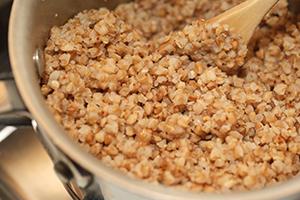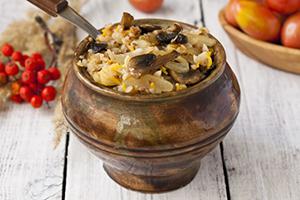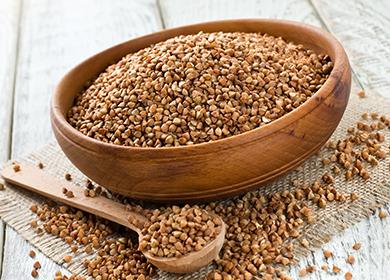The content of the article
The first secret - buckwheat is not cereal. It belongs to the family of herbaceous plants, and its closest relatives are rhubarb and sorrel. That is why there is no cereal gluten protein in cereals, which, with individual intolerance, causes digestive problems in humans. And you can use it with almost no restrictions.
The second secret - they did not begin to grow it at all in Russia, although buckwheat is considered the basis of our national cuisine. A plant native to the Himalayas, another 4 thousand years ago it was present in the culinary of the peoples of Nepal and India, and from there it migrated to Russian Siberia and Altai.
The third secret - the nutritional value of the product is unequal. It strongly depends on the technique of processing grains and the features of their preparation, therefore, the issues of their selection and storage are important.
How to choose and store
There are several varieties of buckwheat on sale. For eating, the premium kernel is ideal. She has large grains that, when properly processed, retain their shape with faces. It contains the maximum share of useful substances, unlike chopping or making, fiber in which is destroyed by mechanical processing.
- When choosing, look at cleanliness. The highest quality product without impurities, does not contain debris.
- Color is important. The lighter the grain, the better. Cream buckwheat suggests that it underwent minimal heat treatment, and therefore retained a maximum of beneficial properties. If the cereal is dark, then it was subjected to intensive steaming. It destroyed more than 40% of valuable elements, so it is no longer suitable for use as healthy food.
- Polyethylene packaging is better. It prevents the grains from absorbing moisture from the environment. Therefore, buckwheat is stored in it for up to 12 months. Plus, in such a package you can see grains well, which a cardboard bundle will not allow to do.
- Storage in airtight containers. Ideally used for storing buckwheat groats glassware with a tight lid. In it, she can lie for several months. The advantage of grains is that they do not rancid even during long-term storage, fungus does not start in them. By the way, the release of toxins in the product during long-term storage is a myth, buckwheat does not accumulate any toxins.
Features of application and composition
If in our country the beneficial properties of buckwheat porridge made it a favorite side dish for meat dishes, then in Italy it was turned into a medicinal product. It can be purchased only in pharmacies, and the use is recommended for pancreatitis, impaired vascular obstruction, and obesity.
And indeed, the benefits of the most familiar cereals are enormous! It contains a whole range of valuable substances.
- Routine - a substance from the group of flavanoids, which enhances the action of vitamin C. The latter has a powerful antiskidant effect, due to which it heals the blood vessels. Vitamin C is also known to be involved in human immunity; therefore, buckwheat porridge may well be considered a prophylaxis against acute respiratory infections in the cold season.
- Magnesium - in every 100 grams of the product as much as 86 mg. This trace element stimulates the relaxation of blood vessels, which reduces blood pressure. That is why the product is recommended for people with impaired cardiovascular system.
- Insoluble fiber - their number in the cereal is large. They stimulate the intestines, facilitating the passage of food. Among the people, buckwheat has long been known as a remedy for constipation. And using it for weight loss allows you to organize the work of the digestive tract.
- Protein - its composition is up to 16%, in an easily digestible form. But vegetable protein does not compensate for all the needs of the body, as it does not contain amino acids. This is important to consider when observing buckwheat mono-diet.
- Minimal fats - only 3%. The benefits of buckwheat porridge are huge for people with metabolic disorders. With diabetes, it lowers glucose levels without saturating the body with harmful fats. And with elevated cholesterol levels, it stimulates its decrease.
Contraindication to the use of the product can only be individual intolerance. It is also important to remember the dangers of mono-diets, and use buckwheat in a varied, balanced diet. It is suitable for starting infant feeding, as the only gluten-free cereal that does not irritate the intestines.
Calorie content and nutritional value
| Product | Calorie content | Squirrels | Fats | Carbohydrates | Glycemic index |
|---|---|---|---|---|---|
| Buckwheat porridge on the water | 90 kcal | 3.7 g | 1.4 g | 20.4 g | |
| Buckwheat porridge in milk | 160 kcal | 6.2 g | 3.5 g | 26.8 g |
How and with what to cook
It is believed that milk is the ideal “partner” for buckwheat. This belief is based on the frequent use of dairy dishes in children's cooking. This combination of fats is really justified, however, only in the nutrition of babies with increased need for calcium.
For adults, it is much more useful to eat buckwheat porridge cooked with vegetables. The abundance of dietary fiber in the croup itself is enhanced by the positive effect of vegetable fiber. This healthy and balanced food is able to saturate the body with vitamins, valuable minerals and eliminate problems with the intestines.
Simple Buckwheat Recipe
The easiest way to prepare cereals is to boil it in salted water.
 You will need:
You will need:
- buckwheat - 1 glass;
- water - 2 glasses
- butter - 1 tsp;
- salt - 1 tsp.
Cooking
- Sort and rinse the grits.
- Pour water into the pan, add salt, and pour buckwheat.
- Let it boil, cover and turn off the gas.
- Cook for 15 minutes before evaporating water.
It is convenient to combine such porridge with any dressings and sauces, it can be served with mushrooms, meat, fish, vegetable side dishes.
Recipe with vegetables
And here we will try to get the most out of a valuable product. Use any vegetables: carrots, onions, cabbage, beets, pumpkin, zucchini ... All your favorite components for the joy of the body!
 You will need:
You will need:
- buckwheat - 2 glasses;
- water - 2 glasses;
- vegetables - 1 kg;
- green peas - 300 g;
- spices, salt.
Cooking
- Prepare the cereal, rinse. Chop vegetables.
- Fold in a clay pot with a lid in layers. Sprinkle with peas on top, add salt.
- Pour in water. Cover.
- Put in a preheated oven, cook at 180 ° 40 minutes.
This recipe uses a small amount of water, as vegetables produce juice during stewing. And porridge is cooked in a vegetable broth.
Now you know the benefits of buckwheat. Eat it with pleasure and good health!

